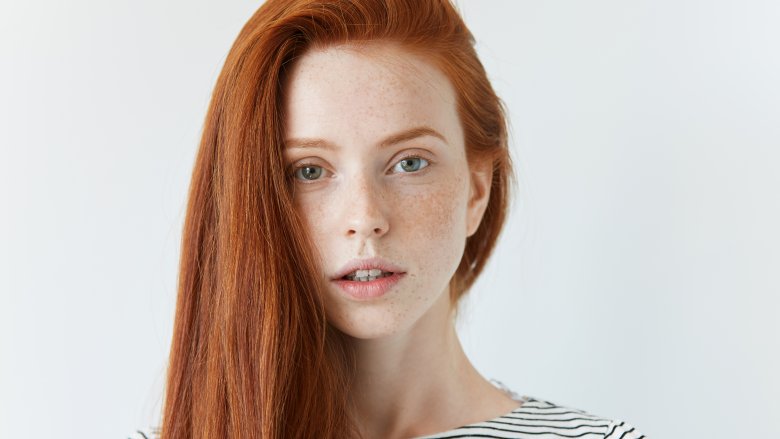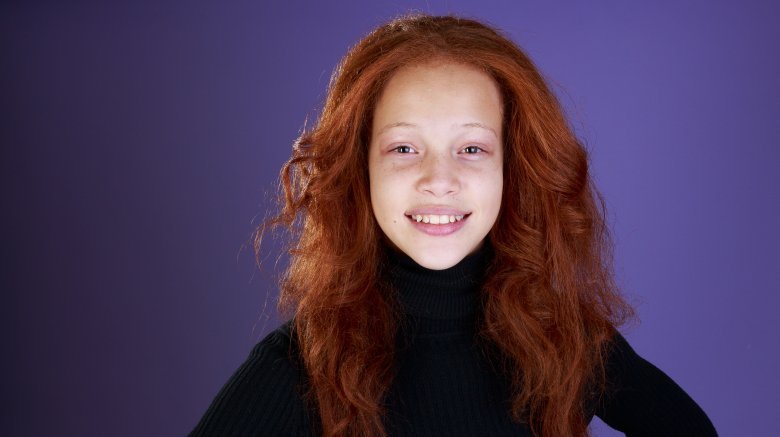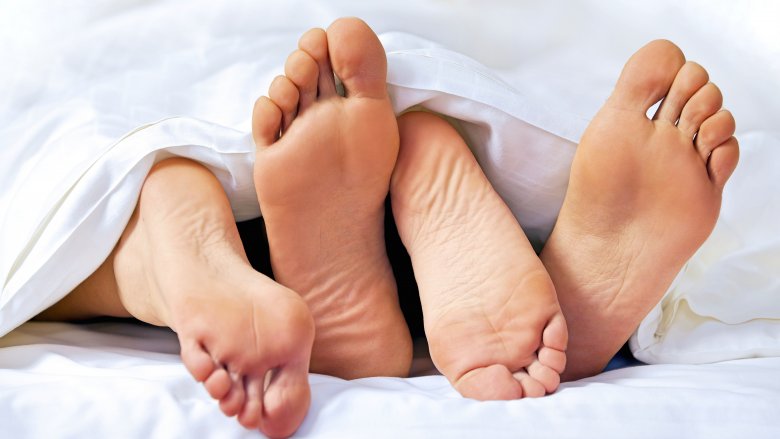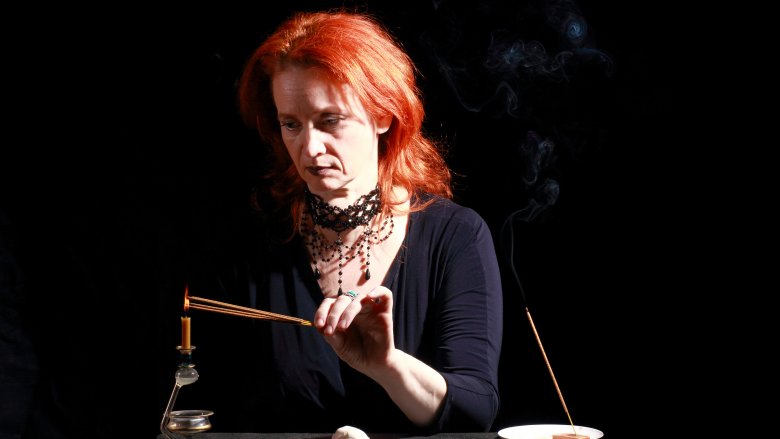Myths About Redheads You Always Thought Were True
The redheaded stepchild. The insatiable ginger girl-next-door. The wimpy redhead who can't handle going to the dentist. The list of stereotypes and myths about our beloved red-haired brethren go on for miles, often maligning those with a fiery crown of flowing locks. For as long as human culture has been documented, redheads have walked among us, often bearing the brunt of the ire of everyone else's perception of them. And for as many freckles that dot their skin, so too are there weird falsehoods in circulation, speculating about everything from the most intimate details to the most obvious things.
But it should come as no surprise that many of the weird rumors and legends that are propagated about gingers aren't always true. So while our redheaded friends really have been persecuted both in history and in contemporary society, they're not stealing souls while you sleep, nor do they turn into vampires when they die. They're also not ready to burst into a tantrum at the tiniest provocation.
Read on as we bust all of the myths about redheads you always thought were true.
All gingers are Caucasian
When you think of famous redheads, who pops to mind first? Perhaps you think of Rupert Grint, who portrayed Ron Weasley in the Harry Potter film franchise. Maybe the face of Jessica Chastain is the first image your memory recalls, or even Prince Harry. Of course, there's one thing all of these fiery souls have in common: They're white.
But just because many of the famous redheads out there are fair-skinned and have Eurocentric features doesn't mean that all gingers do. In fact, there are plenty of folks who have red hair and are of color, according to The Big Redhead Book: Inside the Secret Society of Red Hair by Erin La Rosa. In it, she writes, "Though red hair isn't limited to Caucasian people — there are gingers of color naturally occurring in places like Morocco, Papua New Guinea, and elsewhere." That's right — gingers are everywhere!
The reason for the spread of the redheaded phenotype is due to genetics and migration, according to Barry Starr, a geneticist from Stanford University. "Red hair carriers in the Caribbean and Africa are for the most part due to migration or gene flow," he explained to Vice. Fascinating!
Redheads have fiery tantrums
Surely you've heard the myth that all redheads have not just a short fuse but also a fiery temper. Or perhaps you think that they tend to be bolder and brasher in general and are quick to act on their impulses. After all, the color red is often associated with strong emotions like passion — hence the red boxes of candy that litter the shelves every Valentine's Day.
But the reality is that redheads are inherently no more prone to explosive anger or even curt crankiness than anyone else. They are unfortunately more susceptible than others to being bullied, according to the BBC, so perhaps there's some psychology at work that reinforces the stereotype — constant bullying certainly can have an impact on victims.
But there are some other interesting factors at work here. Redheads do produce more adrenaline than others, according to Red: A History of the Redhead by Jacky Colliss Harvey, which means they "fire up more rapidly than others." And there may be a link between red hair and both Tourette's syndrome and ADHD. So perhaps these play a factor in the stereotype.
They can't stay calm in a crisis
If gingers are more prone to possessing a fiery temper, as the stereotype suggests, so to must they be a hot mess in emergency situations. All of that adrenaline rushing in will no doubt make them lose their minds and start freaking out about the situation as opposed to keeping calm and getting through it, right?
Actually, that couldn't be further from the truth. That's because not only do gingers produce more adrenaline in general, but they also can access it faster than blondes or brunettes, according to Red: A History of the Redhead. And because they can synthesize the hormone more quickly, that makes them more adept in fight-or-flight scenarios. So they'd definitely have a head start while being chased by a bear or getting away from some bad dudes while you straggle behind them.
So when you're assembling your survival squad for the zombie apocalypse, be sure to include a ginger or two — they just might save your life!
Gingers get it on all the time
Another pervasive myth about redheads, especially female redheads, is that they're utterly insatiable in bed and kinky as all heck. You only need to look at Alyson Hannigan's character in American Pie to see the stereotype in action. While she's pretty nerdy for most of the film, she turns into a wild sexpot toward the end. And of course, her character's line about the flute is pretty hard to forget.
It's not just in the media that redheads are painted as nymphomaniacs who will lure you into bed after the first date. There's also a widely cited study by a German sex researcher by the name of Dr. Werner Habermehl that confirms that gingers are more sexually active than blondes or brunettes. But according to The Big Redhead Book, the study wasn't published in any reputable journals, and it didn't it provide any information about who this so-called scientist is. It also didn't address natural vs. dyed hair — sounds like there's something fishy going on, for sure.
Without a scientifically sound study to prove that gingers get it on more often, there's just no corroborating the age-old rumor.
They have more orgasms than regular folk
Hand-in-hand with the idea that gingers get more booty is also the assumption that they climax more often than the rest of us. Indeed that was proven to be true by a study conducted by Match.com, which found that redheaded women are more likely to get there when they're between the sheets. Of course, tons of media outlets jumped on this, furthering the notion that gingers have some pretty sexy superpowers.
But that might not really be the case, according to The Big Redhead Book. That's because, according to author Erin La Rosa, there are some fundamental flaws with how the study was conducted. For one, of the 5,300 people who participated in it, only 186 of them said they were ginger ladies — that's really not a very large sample size. Additionally, based on how the questions were phrased, there's no way to account for who's a natural redhead and who's been assisted by hair dye. Oops!
Because of those two factors, the study does not hold water, at least in regards to this factor.
There's something supernatural about redheads
Historically, our ginger brethren have not had it especially easy, according to U.S. News & World Report. Much of that was due to the beliefs that people in ancient civilizations had about them, which were often rooted in a supernatural fear or concern.
For example, men with red hair were burned alive in ancient Egypt, even though it's thought that Cleopatra herself might have had red hair — who knew? Additionally, Aristotle believed that redheads had bad character, and the early Greeks believed that redheads turned into vampires. But perhaps the most egregious example of gingers being targeted was in medieval Europe, where approximately 45,000 redheaded women were murdered because of suspected ties to witchcraft and magic. Yikes!
Gingers still face various kinds of persecution and discrimination today, according to The Guardian, which is unfortunate to say the least. What is it about redheads that inspires such hatred?
They're genetically just like everyone else
Genetics determine so much about us as people, from the color of our eyes to the size of our noses to how short or tall we end up. That explains why we're all so diverse in a number of ways, thanks to these the tiny codes and directives that determine who we become. But blonde, brunette, jet black, or ginger, we're all pretty much alike on the inside, right?
Surprisingly enough, no — gingers are actually the result of a genetic mutation on the MC1R gene, according to the National Institutes of Health. That explains why being a redhead is so hard to fake, given that it's written into our DNA on the genetic level. Also, you can now enjoy being able to call your redheaded friends mutants — because they are!
Because of the mutation, redheads have less of the dark pigment (eumelanin) and more of the red pigment (pheomelanin) that dictate the shades and hues of our hair and skin. The result is fairer skin, redder hair, and paler eyes than the average person, and, of course, more of those trademark ginger freckles.
Gingers can't take pain like other people
Given that lady gingers are often treated like they have a hot temperament, it makes sense that people may jump to call them shrill if they protest while getting a shot or while undergoing a dental procedure. No one enjoys getting a root canal, after all, and receiving an injection isn't exactly a fun thing to do — but surely everyone feels the same amount of pain when undergoing the same kind of procedure. It's only logical.
Interestingly enough, however, that mutation on the MC1R gene that bestows female redheads with their signature locks also brings with it a greater sensitivity to certain kinds of pain. In one study by the National Institutes of Health, it was revealed that they are more sensitive to thermal pain and more resistant to local anesthetics than the rest of us. Additionally, according to a study in Anesthesiology, they need more anesthesia on the operating table than non-ginger folks. So they're not making a scene or exaggerating their pain — it's real, y'all.
In a fascinating twist, however, redheaded women respond better to painkillers than anyone, including men, according to Science Daily. That's just wild!
Bees sting redheads more often
Weirdly enough, one of the strangest rumors circulating around on the Internet is that redheads are stung by bees and stinging insects more often than their non-ginger counterparts. So claims a listicle on BuzzFeed, which asserts that anecdotal evidence suggests that that this is indeed a thing redheads will attest to.
There's one problem with that theory, though, according to science. For one, there are no legitimate studies that have ever proven that bees are itching to sting Jessica Chastain more than Jennifer Lawrence. Additionally, according to KREM, while bees have a broader range of color vision than humans, they can't really see the color red. That kind of takes the oomph out of that theory, huh?
To be fair, bees are more sensitive to smells than they are to any colors, so maybe there's something at work there. But until it's proven, it looks like we're all at the same risk of getting stung. Ouch!
Our fiery brethren smell just like us
Speaking of smells, there's no rational reason to suspect that redheads would smell any different than other people. But then again, gingers are apparently a little bit more magical than the rest of us, and that applies to how they smell, too. According to The Big Redhead Book, the first documentation of this unique phenomenon was in 1866 in the book Le parfum de la femme by Dr. Augustin Galopin. In it, he theorized that ladies have an aroma that's tied to the color of their mane, and, for redheads, that smell was ambergris. Ooh la la!
Of course, that wasn't exactly hard science, and it wasn't published in a contemporary, peer-reviewed journal. But there is some science at play here, as gingers have a skin mantle that's more acidic than non-gingers. So when they apply perfume or a scented oil to their skin, it smells differently than others. Additionally, gingers may have to re-apply scented products more often, as they don't last quite as long.
Being a redhead is common
If you watch a lot of television and don't skip past the commercials, you've probably noticed that redheads are in an awful lot of them. That's not your imagination — Janet Harris, the president of Upstream Analysis, a social and traditional media analysis firm, summarized study results in an article in HuffPost. According to their findings, redheads are in 30 percent of commercials during prime time, and ginger ladies are twice as likely to appear in them as men. Wendy's, anyone?
But just because they're frequent flyers in advertising doesn't mean gingers are all that common. In fact, according to Red: A History of the Redhead they comprise approximately two percent of the entire world's population, which is really not a lot! In Europe, the stats are a little bit higher, where they account for two to six percent of the population.
So what's the reason gingers are so rare? It comes down to genetics, as being a redhead is a recessive trait — just like having blue eyes is. So if you have red hair and blue eyes, you're practically a unicorn!
Gingers don't need vitamin D
Given that the majority of the ginger population lives in European countries that tend to be cloudier than they are sunny, you might also be tempted to think that they don't need as much vitamin D as other people. But according to The Big Redhead Book, it's not as simple as it seems, of course. More ginger wizardry is afoot!
The deal is that redheads need just as much vitamin D as regular folks do. But since they tend to live in those less-than-sunny places, they've evolved to create vitamin D in their bodies in a more efficient manner than everyone else. So when they do get some sunlight, they can produce more vitamin D in a shorter amount of time.
That's a good thing in another way, too, as our pale-skinned ginger friends are more sensitive to the sun than people with darker skin. Gingers have a fraught relationship with the day star, clearly.
Redheads are wimps when it comes to the cold
If you have a close relationship with a ginger gal, chances are you've noticed that she always carries an extra jacket and scarf with her, or that she curls up with a blanket even when no one else is using one. Chances are you've also gently teased her about always being cold and not being able to handle even the slightest cool-down.
But that doesn't mean the redheaded lady in your life is just being a wimp about the weather, or that it's all in her head — and science proves it. According to a study in the journal Anesthesiology, redheaded women are more sensitive to thermal pain, which means they're super susceptible to the extremes of both cold and hot temperatures. Apparently that MC1R mutation has an impact on the way the gene that detects temperatures functions, causing it to work harder than it needs to. Ah, the mysteries of genetics!
Gingers have no souls
Perhaps the silliest myth about gingers — more so than them being really feisty or super lusty — is the notion that they have no souls. While this bonkers idea may have roots in the historical and cultural persecutions of redheads, it became popular after an episode of South Park. In it, the character of Eric Cartman gives a class presentation, explaining that gingers are soulless and afflicted with a condition called "gingervitis."
Of course, it was just a parody, and it was a satirical way to show how ridiculous discrimination is when it's based on what people look like, or leveled at a group of people for no good reason. And even if there was a scientific way to prove that souls exist, gingers are no more and no less evil than anyone else as a collective. Of course, redheaded individuals can be bad people, but that doesn't have anything to do with their phenotype. Myth busted!














